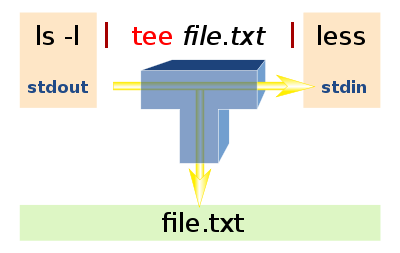http://zh.wikipedia.org/wiki/Tee
tee[编辑]
在计算机科学中,tee是一个常见的指令,它能够将某个指令的标准输出,导向、存入某个档案中。许多不同的命令行界面(Shell)都提供这个功能,如 Unix shell、Windows PowerShell。
tee的功能通常是用管道,让它不但能在屏幕输出,而且也能够将它储存在档案中。当一个资料在被另一个指令或程式改变之前的中间输出,也能够用tee来捕捉它。tee命令能够读取标准输入,之后将它的内容写入到标准输出,同时将它的副本写入特定的档案或变量中。
使用方式[编辑]
tee [ -a ] [ -i ] [檔案 ... ]
参数:
檔案一个或多个档案,能够接收 tee-d 的输出。
Flags:
-a追加到目标文件而不是覆盖-i忽略中断。
|
||||||||||||||||||||||||||||||||
http://codingstandards.iteye.com/blog/833695
用途说明
在执行Linux命令时,我们可以把输出重定向到文件中,比如 ls >a.txt,这时我们就不能看到输出了,如果我们既想把输出保存到文件中,又想在屏幕上看到输出内容,就可以使用tee命令了。tee命令读取标准输入,把这些内容同时输出到标准输出和(多个)文件中(read from standard input and write to standard output and files. Copy standard input to each FILE, and also to standard output. If a FILE is -, copy again to standard output.)。在info tee中说道:tee命令可以重定向标准输出到多个文件(`tee': Redirect output to multiple files. The `tee' command copies standard input to standard output and also to any files given as arguments. This is useful when you want not only to send some data down a pipe, but also to save a copy.)。要注意的是:在使用管道线时,前一个命令的标准错误输出不会被tee读取。
常用参数
格式:tee
只输出到标准输出,因为没有指定文件嘛。
格式:tee file
输出到标准输出的同时,保存到文件file中。如果文件不存在,则创建;如果已经存在,则覆盖之。(If a file being written to does not already exist, it is created. If a file being written to already exists, the data it previously
contained is overwritten unless the `-a' option is used.)
格式:tee -a file
输出到标准输出的同时,追加到文件file中。如果文件不存在,则创建;如果已经存在,就在末尾追加内容,而不是覆盖。
格式:tee -
输出到标准输出两次。(A FILE of `-' causes `tee' to send another copy of input to standard output, but this is typically not that useful as the copies are interleaved.)
格式:tee file1 file2 -
输出到标准输出两次,同时保存到file1和file2中。
使用示例
示例一 tee命令与重定向的对比
[root@web ~]# seq 5 >1.txt
[root@web ~]# cat 1.txt
1
2
3
4
5
[root@web ~]# cat 1.txt >2.txt
[root@web ~]# cat 1.txt | tee 3.txt
1
2
3
4
5
[root@web ~]# cat 2.txt
1
2
3
4
5
[root@web ~]# cat 3.txt
1
2
3
4
5
[root@web ~]# cat 1.txt >>2.txt
[root@web ~]# cat 1.txt | tee -a 3.txt
1
2
3
4
5
[root@web ~]# cat 2.txt
1
2
3
4
5
1
2
3
4
5
[root@web ~]# cat 3.txt
1
2
3
4
5
1
2
3
4
5
[root@web ~]#
示例二 使用tee命令重复输出字符串
[root@web ~]# echo 12345 | tee
12345
[root@web ~]# echo 12345 | tee -
12345
12345
[root@web ~]# echo 12345 | tee - -
12345
12345
12345
[root@web ~]# echo 12345 | tee - - -
12345
12345
12345
12345
[root@web ~]# echo 12345 | tee - - - -
12345
12345
12345
12345
12345
[root@web ~]#
[root@web ~]# echo -n 12345 | tee
12345[root@web ~]# echo -n 12345 | tee -
1234512345[root@web ~]# echo -n 12345 | tee - -
123451234512345[root@web ~]# echo -n 12345 | tee - - -
12345123451234512345[root@web ~]# echo -n 12345 | tee - - - -
1234512345123451234512345[root@web ~]#
示例三 使用tee命令把标准错误输出也保存到文件
[root@web ~]# ls "*"
ls: *: 没有那个文件或目录
[root@web ~]# ls "*" | tee -
ls: *: 没有那个文件或目录
[root@web ~]# ls "*" | tee ls.txt
ls: *: 没有那个文件或目录
[root@web ~]# cat ls.txt
[root@web ~]# ls "*" 2>&1 | tee ls.txt
ls: *: 没有那个文件或目录
[root@web ~]# cat ls.txt
ls: *: 没有那个文件或目录
[root@web ~]#
问题思考
相关资料
【1】Linux公社 linux tee命令详解
【2】百度知道 linux tee 命令的详细使用, 越详细越好.
【3】脚本学习 linux tee命令: 将标准输出一分为二
【4】起航工作室 linux tee 命令详解
【5】5Linux教程 Linux tee command
